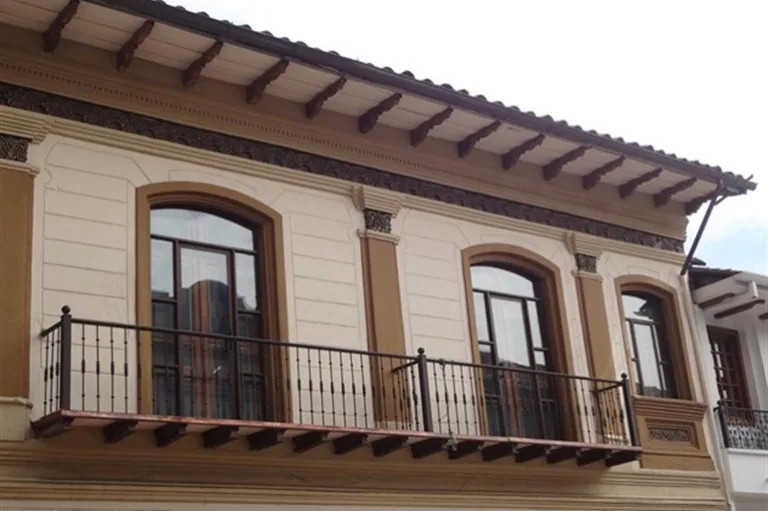For Cuenca pedestrians, the pandemic has changed some walking rules but most remain the same
By Sylvan Hardy
A notable byproduct of the pandemic for many expats is that they are walking more. The news of a year ago that the Covid-19 virus rarely transmits outdoors, set many of us free from the cabin fever we suffered since the first lockdowns began last March and sent us exploring the far reaches of the historic district and other Cuenca neighborhoods.

Walking is one of the joys of living in Cuenca but you need to know the rules of the sidewalks and the roads.
Although the pandemic has changed a few of the pedestrian rules in Cuenca – the huge increase in the number of motorcycles on the streets since the beginning of 2020 is a big one – most others remain the same. Here’s a quick review the “rules of sidewalks” for walkers.
No matter where they’re practiced, the rules of pedestrianism have to accommodate the local culture and condtions. In Cuenca, and almost all of Latin America for that matter, the first rule is that you’re responsible for your own safety, a critically important fact that most newcomers learn quickly. When you are on the hoof in Cuenca, consider yourself a marked woman or man, and expect minimum consideration from the drivers careening down the streets and avenues. If you begin with this thought in mind you will often be pleasantly surprised by the courtesies you are shown by motorists.
Sturdy walking shoes are mandatory for pedestrians. And you have to be careful where you put those sturdy shoes, since you’ll encounter plenty of hazards, including potholes, uneven pavement, and tiled surfaces that become slick when wet. You’ll navigate narrow, centuries-old cobblestone streets and narrow sidewalks providing various widths of passage; some buildings jut out and crowd the street, only a curb away from the clattering traffic. Walking into the street in such situations presents obvious dangers.

Crossing the street can be an adventure in Cuenca.
And watch out for the sudden, short, and steep driveways cut from the curbs every few meters, plus other ankle-twisting irregularities. Sprained and even broken ankles are common among expats, especially those who’ve just arrived and are not familiar with the pitfalls.
A seldom-mentioned hazard is posed by truck and bus mirrors. Because sidewalks often extend to the street curb, and because streets are narrow, mirrors of passing vehicles sometimes protrude over sidewalk space. Every year, three or four pedestrians walking on the street-side of sidewalks get whacked and at one expat was badly incurred a couple years ago. Don’t walk on the edge!
Although the laws protecting pedestrian rights are similar to those in North America and Europe, they’re seldom enforced and you’d be foolish to attempt to assert them in the face of thousands of pounds of oncoming steel. Contrary to local urban legend, by law, vehicles are supposed to yield to pedestrians when they make right turns – just don’t count on it.
Dogs can pose a special threat to walkers. Although most street dogs you encounter in the historic district will pay you little attention, those that are outside their yards in outlying neighborhoods can be aggressive. Occasionally, walkers encounter packs of aggressive dogs. A walking stick provides protection and some walkers carry aerosol cans of pepper or bear spray. Others carry one of the flashlight/electric stun guns that have become popular with expats in recent years. In shock mode, the gun sets off a terrifying racket that scares away critters of all sizes without requiring direct contact of the business end of the device. As an aside, expats report that the noise of the stun gun has also been known to chase off would-be muggers who mistake it for gun shots.
New hazards with the pandemic
As mentioned earlier, the number of motorcycles on Cuenca streets has risen by an astonishing 25 percent since the pandemic began. Many of them are involved in the food delivery service, which EMOV, the Cuenca transportation authority, says has increased by 600 to 700 percent since March 2020, when the first lockdown was ordered.

A Venezuelan refugee family begs on an El Centro streeet.
Unfortunately, many motorcyclists do not obey the law. They routinely run red lights and stop signs, they navigate between lanes of stopped cars and they drive too fast. In addition, their fast acceleration from a stop often catches jaywalkers off guard. Although police have been busy checking licenses and registrations at roadblocks, they seem less interested in ticketing moving violations.
Pedestrians beware!
Bicycles and electric scooters have also proliferated during the pandemic and pose a clear and present danger, particularly on sidewalks. Again, stay alert.
Although it is usually not a hazard, the explosion of beggars on Cuenca streets is an obstacle that must be navigated. In El Centro, it is not unusual to see two or three begging Venezuelan families on a block. In addition, there are the elderly and disabled Cuencanos who were on the streets before the refugees arrived and who must now share their collections.
For many pedestrians, walking the gauntlet of outstretched hands and pathetic pleas is both heartbreaking and irritating. It is widely known that most Venezuelan beggars work for handlers who collect their proceeds in exchange for housing and food, and transportation between cities. And then there’s the investigation announced by the National Police that the children who sit or lie pitifully beside them are being drugged. Nonetheless, their situation is tragic and humiliating with no end in sight. Those who pass the beggars, locals as well as refugees, must make their own decisions about how much to give and who to give it to.
Despite the hazards and considerations, new and old, most expat walkers would agree with poet and former New Yorker editor, Calvin Trillin, that Cuenca is one of the “great walking around cities in the world.”


















